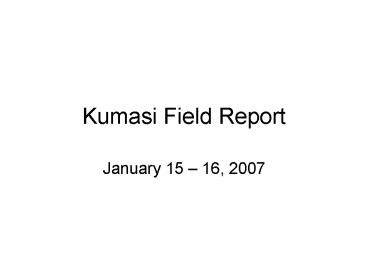Kumasi Field Report - PowerPoint PPT Presentation
1 / 15
Title:
Kumasi Field Report
Description:
Dr. Alfredo MacArthur, NACP Mozambique. Dr. Bernard Dornoo, WHO-NACP Ghana ... Prohibitive lab costs for biochemistry tests. Pharmacy Capacity ... – PowerPoint PPT presentation
Number of Views:39
Avg rating:3.0/5.0
Title: Kumasi Field Report
1
Kumasi Field Report
- January 15 16, 2007
2
Team Composition
- Mr. Israel Sembajwe, ECA
- Dr. Alfredo MacArthur, NACP Mozambique
- Dr. Bernard Dornoo, WHO-NACP Ghana
- Dr. Richard Amenyah, FHI Ghana
- Cassandra de Souza, World Bank
3
Sites Visited
- Komfo Anokye Teaching Hospital, Kumasi
- St. Michaels Hospital, Pramso
- Obuasi Government Hospital
- AngloGold Ashanti Hospital, Obuasi
4
Health Social Demographics
- Ashanti Region, 21 districts
- Population is 4.2 million
- HIV prevalence 3.0 vs. 2.7 national
- 7 ART sites, 34 PMTCT and VCT sites
- Over 5,000 enrolled patients
- Almost 2,200 patients on ART
5
ART Situation Overview
- ART initiated in region in February 2004
- 6 additional sites added during 2006
- 98 of ART patients are at K.A.T.H
- Most patients are diagnostic referrals,
presenting late - Team approach to care (5 trained staff per site)
- Patient inflow follows national protocol
guidelines - Walk-in/referral, initial nurse assessment,
doctor initiated treatment, 3 adherence
counseling sessions
6
TAP Implementation
- Implementation begun in 2006
- Each site has less than 50 ART patients
- Public private partnership operational eg.
Obuasi Govt. and Anglogold, St. Michaels, CRS and
Kumasi South - Regular monitoring and supervision provided
- Some HBC and community outreach evident eg.
Anglogold and community engagement Pramso social
mobilization
7
Laboratory Capacity
- CD4 machines not available in all sites samples
taken to other sites, strengthen links - Highly controlled utilization of machines
- Chemical analyzer not available in most sites
- At least 2 motivated and well-trained lab techs
per site (heavily involved in care) - HIV lab reagent stockouts in past 6 months
- Prohibitive lab costs for biochemistry tests
8
Pharmacy Capacity
- Pharmacists integrated in overall care provision
often serve as adherence counselors - Regular drug monitoring and reporting
- No stockouts in last 6 months for 1st line
regimen - Shortage of 2nd line drugs at K.A.T.H.
9
Integration/Linkages
- PMTCT and TB are integrated
- STIs referral linkage is weak
- VCT weak generally, mostly diagnostic CT which is
well integrated
10
Supporting Activities
- Training for 5 staff per site prior to ART
initiation - Regular technical support provided (for TAP
sites) - Regular programmatic supervision by regional AIDS
coordinator (quarterly) - Strengthen the quality assurance system for
scaling up to new sites to monitor adherence to
standards (with checklist)
11
Monitoring Evaluation
- Sites provide monthly programmatic reports to
Regional AIDS Coordinator (K.A.T.H. sends direct
to NACP) - TAP sites provide monthly reports to implementing
partner (FHI,NCHS unclear) - Data collected but not locally analyzed and
utilized for programmatic decisions - Utilization of national reporting format for
figures, age and gender defined
12
Good Practices
- Public Private Partnership
- Good collaboration between Anglogold and Obuasi
hospitals - Where available, engagement of other partners
(CRS and St. Michaels) - Team approach and skills mix
- Self-motivated and committed lab technicians and
pharmacists - Free services to employees and dependants at
Anglogold - Staff mentoring by IPs
13
Constraints/Challenges
- Cost, cost, cost, cost!
- Chemical analyzers needed
- Space limitations in some sites
- Late entry into care
- Adherence monitors sometimes challenging
- Human resource limitations
- Low utilization of ART services
- Low community mobilization and interventions
- Stigma
14
Recommendations
- Regular and well-planned technical support and
supervision should be strengthened - Strengthen quality assurance system for new sites
to monitor adherence to standards (with
checklist) - VCT promotion highlighted as a primary prevention
mechanism and for early ART initiation - Significant improvement in community outreach
activities social marketing of VCT and ART
marketing - Need aggressive identification of paediatric
cases - Provision of basic lab equipment
- Strategic HR capacity building for all sites
need-based - Localized data analysis and utilization for
ownership - Review of 50,000 cedis package charge and policy
guidance on use of these funds - Inclusion of ARVs in health insurance scheme
15
- Obrigado
- Webale Nnyo
- Me da se
- Zikomo































